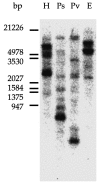Chromosomal localization of three human poly(A)-binding protein genes and four related pseudogenes
- PMID: 10543404
- PMCID: PMC1865476
- DOI: 10.1007/s004399900148
Chromosomal localization of three human poly(A)-binding protein genes and four related pseudogenes
Abstract
In humans, the poly(A)-binding proteins (PABPs) comprise a small nuclear isoform and a conserved gene family that displays at least three functional proteins: PABP1, inducible PABP (iPABP), and PABP3, plus four pseudogenes (1, 2, 3, and PABP4). In situ hybridization of PABP3 cDNA as the probe on metaphasic chromosomes have revealed five possible loci for this gene family at 2q21-q22, 13q11-q12, 12q13.3-q15, 8q22, and 3q24-q25. Amplifications of specific DNA fragments from a human-rodent somatic cell hybrid panel have allowed us to associate PABP1 and PABP3 with 8q22 and 13q11-q12, respectively. The iPABP gene has been assigned to chromosome 1. This result, compared with radiation hybrid database information, strengthens the location of this gene to 1p32-p36. The pseudogenes PABP4, 1, and 2 have been assigned to chromosomes 15, 4, and 14, respectively. Three loci detected on chromosome spreads are not associated with any amplified fragment. They might represent other related PABP genes not yet identified.
Figures





References
-
- Brais B, Bouchard JP, Xie YG, Rochefort DL, Chretien N, Tome FM, Lafreniere RG, Rommens JM, Uyama E, Nohira O, Blumen S, Korczyn AD, Heutink P, Mathieu J, Duranceau A, Codere F, Fardeau M, Rouleau GA. Short GCG expansions in the PABP2 gene cause oculopharyngeal muscular dystrophy [erratum in Nat Genet 1998 19:404] Nat Genet. 1998;18:164–167. - PubMed
-
- Giuili G, Scholl U, Bulle F, Guellaen G. Molecular cloning of the cDNAs coding for the two subunits of soluble guanylyl cyclase from human brain. FEBS Lett. 1992;304:83–88. - PubMed
Publication types
MeSH terms
Substances
Associated data
- Actions
- Actions
- Actions
- Actions
- Actions
- Actions
- Actions
- Actions
- Actions
- Actions
- Actions
- Actions
LinkOut - more resources
Full Text Sources
Molecular Biology Databases

